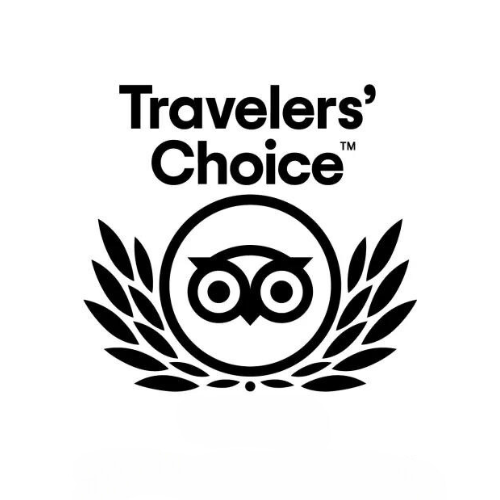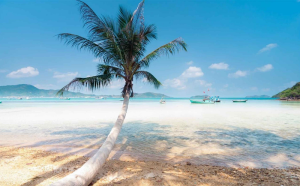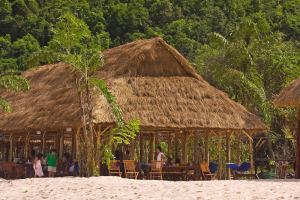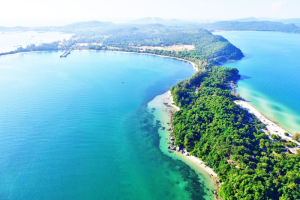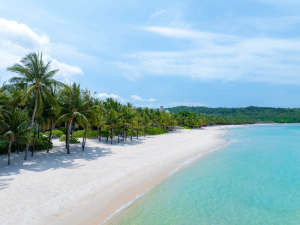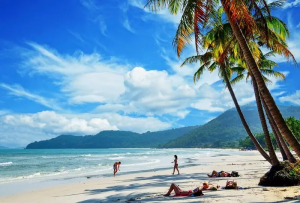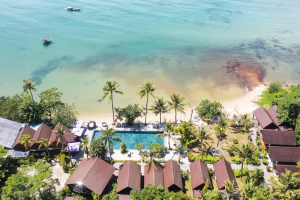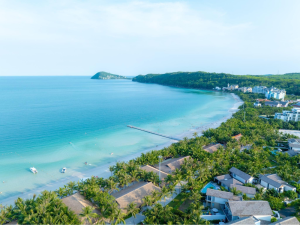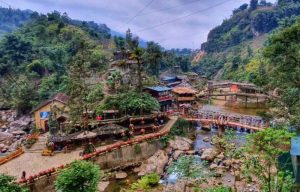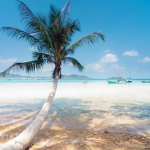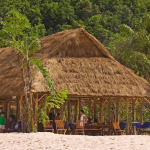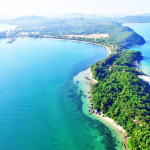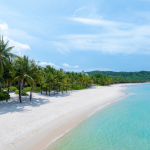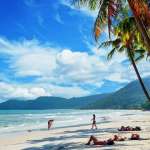
Vietnam Ba Be National Park is a protected area with a wide range of ecosystems, such as rivers, lakes, limestone mountains, and forests.
What is Ba Be National Park and where is it located?

Vietnam Ba Be National Park is a wonderful place for eco-tourists that appreciate nature and adventure. Ba Be Park, which is known as the “treasure of Bac Kan mountains and forests,” often amazes and fascinates visitors when they get the chance to see it. When you come here, you’ll be surrounded by beautiful natural surroundings, see a wide range of plants and animals, and best of all, eat delicious local food.
Vietnam Ba Be National Park is located in Ba Be District, Bac Kan Province, spanning across five communes: Quang Khe, Khang Ninh, Cao Tri, Cao Thuong, and Nam Mau. Known as the “treasure of Bac Kan mountains and forests”, this place is famous for many beautiful landscapes. Among them, the most prominent is Ba Be Lake – one of the largest natural freshwater lakes in Vietnam and the world.
Natural landscapes and biodiversity of Ba Be National Park

Vietnam Ba Be National Park has Ba Be Lake, which is the largest natural freshwater lake in Vietnam. It is bordered by limestone mountains and tropical vegetation. It has many different plants and animals, some of which are endangered. Thus, it is an important place for nature to live.
- Natural Landscapes
- Lake Ba Be: It is made up of three lakes that are connected to each other: Pe Leng, Pe Lu, and Pe Lam. It is a beautiful lake that originated 200 million years ago. There are beautiful limestone mountains and thick tropical woods all around the lake.
- Caves: Puong Cave is a famous cave with intriguing incrustations that was made by river erosion. Fairy Pond is a small lake surrounded by limestone rocks and vegetation.
- Waterfalls: Another well-known natural feature in the park is the Dau Dang waterfall.
- Biodiversity
- Flora: The park has various evergreen woods and ponds.
- Fauna: Ba Be National Park is home to many different kinds of animals, including some that are in risk of extinction, such as the Francois’ Langur monkey, the Owston palm civet, and the Asian black bear. There are 106 kinds of fish that live in the lake and rivers.
- Aquatic life: The lake is home to many aquatic species, some of which are uncommon and endangered.
- Other important things: The park is on the tentative list of UNESCO World Heritage Sites and is also a Ramsar site, which shows how important it is to the world. It is also a historical landmark that has to do with Vietnam’s national defense and building.
The park is noted for its eco-friendly tourist policies, which let people enjoy its natural beauty in a responsible way.
Top things to do in Ba Be National Park

Vietnam Ba Be National Park has many things to do for people who enjoy nature and adventure.
Take a Ba Be Lake Cruises
Take a boat or kayak ride around Ba Be Lake, the largest natural freshwater lake in Vietnam, to see its stunning beauty. Ba Goa Island, An Ma Temple, and Fairy Pond are all popular places to go. On the Ba Be Lake Cruises, you can have chances to relax and try the traditional foods with the 5-star services while admiring Ba Be lake’s beauty.
Hiking
The park has a number of hiking trails, from short walks to tough hikes, that let you explore the park’s different ecosystems and take in the grandeur of the mountains and forests around it.
Moreover, you can take advantage of the park’s natural splendor by doing things like bamboo rafting, swimming, and even camping on the lake.
Exploration
Explore the park’s fascinating caves, such as Hua Ma Cave, which is renowned for its beautiful stalactites and stalagmites. You can also visit the park’s Waterfalls like Silver Waterfall, which offer beautiful views and a cool, refreshing atmosphere.
Cultural Immersion
Get to know the Tay, Dao, and H’mong ethnic groups by staying with them in their homes and learning about their customs. You can also visit nearby villages: Visit Pac Ngoi village, which is recognized for its traditional stilt dwellings and its strong ties to Ba Be Lake. Learn about the culture, food, and daily lives of the people who live there.
How to get to Ba Be National Park

Ba Be national park is around 240 km from Hanoi. As a tourist spot, you can find ba be national park map easily on your map applications. So you can get there by one of the following ways:
- Bus
You can take a bus from Hanoi to Bac Kan Province at either the My Dinh or Yen Nghia bus stations. Many tourist buses, such as An Binh, and Thuong Nga operate buses from Hanoi to Bac Kan. The price of a ticket ranges from 200,000 to 250,000 VND for each trip. Furthermore, you can take service buses that go straight to Ba Be National Park. Each vehicle can hold around 15 people, and tickets cost 280,000 VND each way.
- Your own car or motorcycle
If you’re driving or riding a motorcycle, take the Hanoi-Thai Nguyen highway and then turn onto National Highway 3. Turn left at the TL 268 crossroads to get to Dinh Hoa (Cho Chu). From here, go 40 km via TL 254 to Bang Lung (Cho Don) and then 40 km to Ba Be National Park. But Lily’s Travel does not advise you to drive by yourself because you are not Vietnamese.
- Plane: If you are not in Hanoi, you need to fly to Hanoi first. Then you can take a bus or rent a motorbike to go there. Lily’s Travel can help you purchase a flight to Hanoi with the best prices.
Best time to visit Ba Be National Park

Ba Be national park weather is clearly separated. The dry season, which lasts from March to May and September to November, is the best time to go to Vietnam Ba Be National Park. The weather at this time is lovely, with cooler temperatures and less rain. This makes it the best time to do things outside like hiking, boating, and exploring the park’s trails.
- From March to May and from September to November: These months are known as the “shoulder seasons” since the temperature is warm. This makes them perfect for enjoying the park’s natural splendor and doing things outside.
- Don’t go during the rainy season (May to September): Heavy rain around this time can make trails slick and difficult to walk on, which could make it harder to explore.
- The dry season lasts from October to April. During this time, the weather is cooler and there is less rain, making it a good time to explore the park’s many different landscapes.
Read more: Na Hang Lake: The hidden gem in Tuyen Quang
Sustainable travel tips for visiting Ba Be National Park
When you visit Vietnam Ba Be National Park, try to have as little of an impact on the environment as possible by doing things like eliminating waste, respecting wildlife, and helping local communities. Choose tour companies that are good for the environment, bring things that can be used again, and know how much you use. Get to know the local culture and traditions, and make sure to throw away your trash so that no one knows you were there.
1. Pick tour companies that are good for the environment
- Do your research and book with tour companies who care about the environment, have a small impact on it, and help local communities.
- Find tour companies that are open about how they run their businesses and show that they care about ethical tourism.
If you are wondering to find a agency, please contact Lily’s Travel to get more information and book a tour created suitable for you.
2. Pack smart and light
- To avoid using plastic once, bring reusable shopping bags, water bottles, and containers.
- Choose biodegradable and eco-friendly toiletries.
- To lower your carbon footprint while traveling, pack light.
3. Respect the Environment and Wildlife
- Stay on marked routes and don’t disturb wildlife habitats.
- Keep a safe distance from animals, and don’t bother them while they’re doing what they do naturally.
- Don’t throw trash on the ground; instead, throw it away correctly so that the park stays clean.
- Don’t pick flowers or plants, and be aware of how your actions affect the environment.
4. Support local communities
- Get to know the people who live there and their customs and traditions by treating them with respect.
- Buy handicrafts, things made in the area, and services to help local companies.
- To help the area’s economy, think about staying in a place that is owned by a local.
5. Be mindful of water and energy consumption
- During your stay, take shorter showers and save water.
- When you’re not using lights and appliances, turn them off to save electricity.
6. Plan your visit for optimal conditions
- Look into the best times to go to Ba Be National Park, taking into account the weather and how it could affect trails and activities.
- The dry season, which includes spring and fall, is usually the best time to go. The rainy season, on the other hand, can make routes slick and cause more water to flow.
- Hike early to avoid the afternoon heat and enjoy the park.
- You may have a responsible and eco-friendly trip to Ba Be National Park by following these guidelines. This will help protect the park’s natural beauty and heritage for future generations.
Ba be National Park is a beautiful and ecologically rich place in Vietnam that shows how beautiful nature can be. It should be preserved and appreciated for generations to come because of its beautiful vistas, cultural importance, and environmental worth.
Read more: An Ma Temple: The final resting place of Mac Dynasty generals

